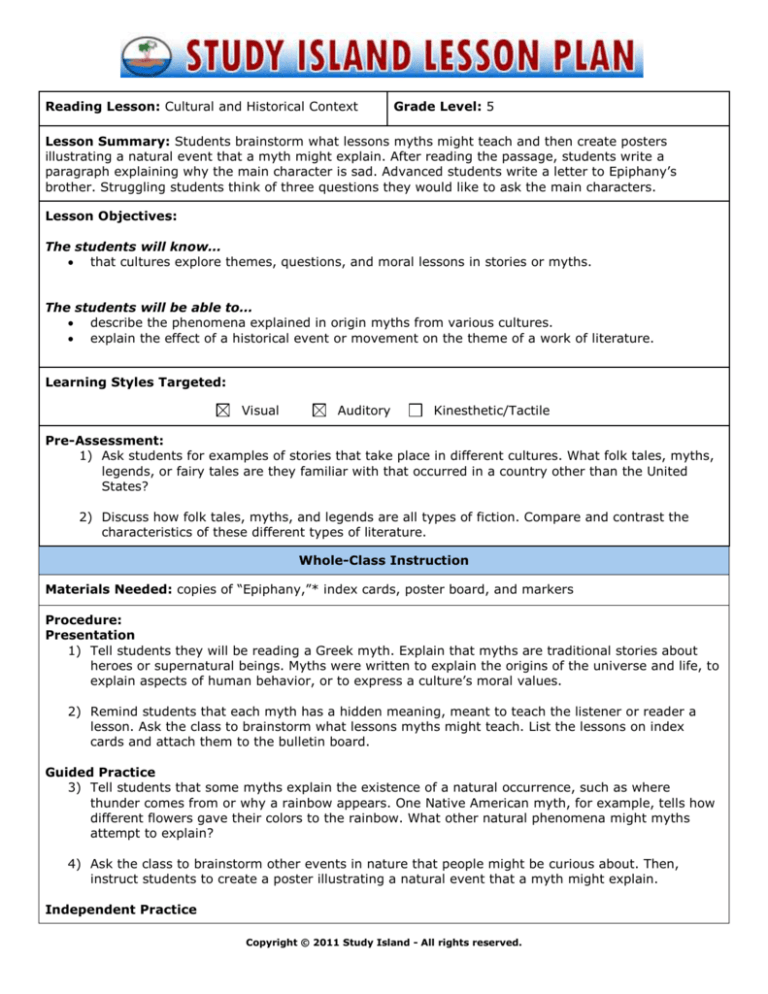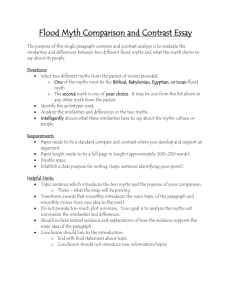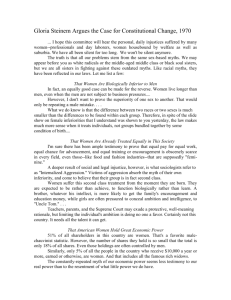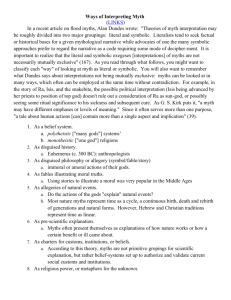
Reading Lesson: Cultural and Historical Context
Grade Level: 5
Lesson Summary: Students brainstorm what lessons myths might teach and then create posters
illustrating a natural event that a myth might explain. After reading the passage, students write a
paragraph explaining why the main character is sad. Advanced students write a letter to Epiphany’s
brother. Struggling students think of three questions they would like to ask the main characters.
Lesson Objectives:
The students will know…
that cultures explore themes, questions, and moral lessons in stories or myths.
The students will be able to…
describe the phenomena explained in origin myths from various cultures.
explain the effect of a historical event or movement on the theme of a work of literature.
Learning Styles Targeted:
Visual
Auditory
Kinesthetic/Tactile
Pre-Assessment:
1) Ask students for examples of stories that take place in different cultures. What folk tales, myths,
legends, or fairy tales are they familiar with that occurred in a country other than the United
States?
2) Discuss how folk tales, myths, and legends are all types of fiction. Compare and contrast the
characteristics of these different types of literature.
Whole-Class Instruction
Materials Needed: copies of “Epiphany,”* index cards, poster board, and markers
Procedure:
Presentation
1) Tell students they will be reading a Greek myth. Explain that myths are traditional stories about
heroes or supernatural beings. Myths were written to explain the origins of the universe and life, to
explain aspects of human behavior, or to express a culture’s moral values.
2) Remind students that each myth has a hidden meaning, meant to teach the listener or reader a
lesson. Ask the class to brainstorm what lessons myths might teach. List the lessons on index
cards and attach them to the bulletin board.
Guided Practice
3) Tell students that some myths explain the existence of a natural occurrence, such as where
thunder comes from or why a rainbow appears. One Native American myth, for example, tells how
different flowers gave their colors to the rainbow. What other natural phenomena might myths
attempt to explain?
4) Ask the class to brainstorm other events in nature that people might be curious about. Then,
instruct students to create a poster illustrating a natural event that a myth might explain.
Independent Practice
Copyright © 2011 Study Island - All rights reserved.
5) Have students look up the word “epiphany” prior to reading the myth of the same name. Point out
that there are several definitions, but the one that relates to the myth pertains to a sudden
revelation of an essential truth or reality.
6) Have students read the myth and then write a paragraph explaining why the character Epiphany is
sad at the conclusion of the story.
Closing Activity
7) Have students draw and name a shadow, and then write a sentence comparing their shadow with
the thing that made it.
Advanced Learner
Materials Needed: paper and pencil
Procedure:
1) Tell students they will assume the role of Epiphany and then write a letter to Epiphany’s brother.
The letter should discuss how he has mistaken shadows of images for reality. In their letters,
students should emphasize why Epiphany wanted to share her discovery of the real Avis and Arbor
with her brother.
2) Ask students to imagine how Epiphany felt when she first saw the bird and olive tree in reality, and
then contrast that with how she felt when she returned to the shadow world inside the cave.
3) Give students the opportunity to read their letters to the class.
Struggling Learner
Materials Needed: paper and pencil
Procedure:
1) Tell students that they should think of three questions that they would like to ask Epiphany and/or
her brother.
2) Reread the myth to students. Ask them to picture the differences between the shadows in the cave
and the reality of the world outside with the colorful bird and the old olive tree.
3) Ask students to write their three questions and then share them with the group. What answers
might the main characters respond with?
*see supplemental resources
Copyright © 2011 Study Island - All rights reserved.









